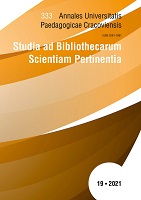Zwiększenie czytelności wypowiedzi w polskim języku migowym przez animowaną wirtualną postać. Badania użytkowników z wykorzystaniem nowych technologii
On Improved Comprehensibility of Utterances in the Polish Sign Language Thanks to the Use of an Animated Virtual Assistant. Assessment of New Technologies
Author(s): Anna IRASIAK, Elżbieta Sroka, Adam Piasecki Subject(s): Media studies, Electronic information storage and retrieval, Western Slavic Languages, Theory of Communication, ICT Information and Communications Technologies
Published by: Wydawnictwo Uniwersytetu Komisji Edukacji Narodowej w Krakowie
Keywords: Avatar; virtual assistant; Polish Sign Language; sign communication; comprehensibility of communication; accessibility of communication; effectiveness of research tools;
Summary/Abstract: Research in construction of sign language avatars, which are computer-generated representations of linguistic phenomena, can be used to arrive at solutions facilitating communication with hearing-impaired persons. The clarity of content of the sign communication is particularly important for its recipient. As part of its project “How to Increase the Comprehensibility of Utterances in the Polish Sign Language through Animated Virtual Assistant”, the research network Łukasiewicz – Instytut Technik Innowacyjnych EMAG from Katowice (Ł-EMAG)23 has undertaken research with a view to evaluating the efficacy of the Polish Sign Language (PJM) through a virtual assistant; the other objective is to single out those traits which most contribute to satisfactory reception and comprehension of communication. The present article reports on the comparative studies conducted so far, which include surveys and in-depth interviews with hearing-impaired users of sign language by means of dedicated research tools. The first (introductory) stage consisted in gathering users’ opinions on the comprehensibility of the sign language of the first created avatar, including features which either facilitate of hinder communication as well as the level of experience of hearing-impaired persons in the use of on-line translators. In the second stage, a model of a 3D virtual assistant was developed, which took into consideration all the above-mentioned features facilitating or hindering communication. This part of the research yielded data concerning the comprehensibility of the virtual avatar as well as users’ comparison of the two avatars.
Journal: Annales Universitatis Cracoviensis. Studia ad Bibliothecarum Scientiam Pertinentia
- Issue Year: 2021
- Issue No: 19
- Page Range: 664-684
- Page Count: 21
- Language: Polish

